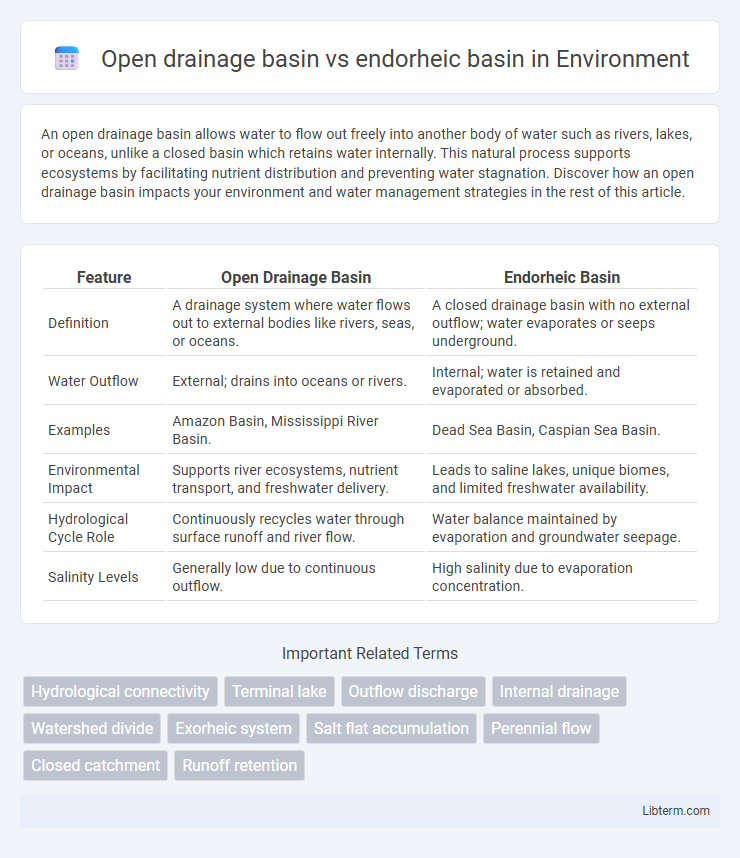An open drainage basin allows water to flow out freely into another body of water such as rivers, lakes, or oceans, unlike a closed basin which retains water internally. This natural process supports ecosystems by facilitating nutrient distribution and preventing water stagnation. Discover how an open drainage basin impacts your environment and water management strategies in the rest of this article.
Table of Comparison
| Feature | Open Drainage Basin | Endorheic Basin |
|---|---|---|
| Definition | A drainage system where water flows out to external bodies like rivers, seas, or oceans. | A closed drainage basin with no external outflow; water evaporates or seeps underground. |
| Water Outflow | External; drains into oceans or rivers. | Internal; water is retained and evaporated or absorbed. |
| Examples | Amazon Basin, Mississippi River Basin. | Dead Sea Basin, Caspian Sea Basin. |
| Environmental Impact | Supports river ecosystems, nutrient transport, and freshwater delivery. | Leads to saline lakes, unique biomes, and limited freshwater availability. |
| Hydrological Cycle Role | Continuously recycles water through surface runoff and river flow. | Water balance maintained by evaporation and groundwater seepage. |
| Salinity Levels | Generally low due to continuous outflow. | High salinity due to evaporation concentration. |
Introduction to Drainage Basins
Open drainage basins, also known as exorheic basins, discharge water into external bodies such as rivers, lakes, or oceans, facilitating continuous water flow and nutrient cycling. Endorheic basins, in contrast, retain water within closed catchments where evaporation or seepage dominates, preventing outflow and often resulting in saline or alkaline lakes. Understanding these drainage basin types is essential for hydrological studies, water resource management, and ecological conservation.
Defining Open Drainage Basins
Open drainage basins, also known as exorheic basins, are land areas where surface water drains outward into external bodies like rivers, lakes, or oceans, facilitating continuous water flow. These basins contrast with endorheic basins, which retain water internally without outlet to seas, leading to the formation of salt lakes or evaporative basins. Hydrological characteristics of open drainage basins enable nutrient and sediment transport, influencing regional ecosystems and freshwater availability.
Understanding Endorheic Basins
Endorheic basins are closed drainage systems where water does not flow out to external bodies like oceans or rivers, instead accumulating in lakes or evaporating. These basins often create saline or alkaline lakes due to high evaporation rates and mineral concentration, such as the Caspian Sea or the Dead Sea. Understanding endorheic basins involves studying their geologic isolation, climatic conditions, and hydrological balance, crucial for water resource management and ecosystem sustainability.
Key Differences Between Open and Endorheic Basins
Open drainage basins have external outflows that allow water to drain into rivers, lakes, or oceans, facilitating continuous water circulation and sediment transport. Endorheic basins are closed drainage systems with no external outlets, causing water to accumulate and evaporate, often leading to high salinity and unique ecological conditions. The primary difference lies in water discharge behavior--open basins maintain hydrological connectivity, while endorheic basins create isolated water bodies affecting regional climate and biodiversity.
Hydrological Processes in Open Drainage Basins
Open drainage basins facilitate continuous surface water flow into rivers, lakes, or oceans, promoting efficient drainage and groundwater recharge. These basins support dynamic hydrological processes, including precipitation runoff, infiltration, and evapotranspiration, contributing to stable water cycles. The connectivity of open drainage systems reduces water stagnation and enhances sediment transport, influencing ecosystem health and flood management.
Water Cycle Dynamics in Endorheic Basins
Endorheic basins exhibit unique water cycle dynamics characterized by the absence of external drainage, causing water to accumulate in lakes or evaporate, unlike open drainage basins that channel water to oceans. Evaporation and infiltration dominate the hydrological processes, often resulting in high salinity levels due to mineral concentration. These closed systems significantly influence regional groundwater recharge and climate patterns, making their water balance sensitive to climatic fluctuations.
Ecological Impacts of Basin Types
Open drainage basins discharge water into oceans or seas, supporting diverse aquatic ecosystems and promoting nutrient cycling through river outflows, which sustain coastal habitats. Endorheic basins, characterized by internal drainage with no outlet to the sea, often lead to high salinity and limited water exchange, resulting in unique but fragile ecosystems prone to salinization and habitat loss. The ecological impacts of these basin types influence biodiversity, water quality, and regional climate regulation, with open basins generally supporting richer biodiversity and more stable hydrological processes.
Examples of Major Open and Endorheic Basins Worldwide
Major open drainage basins include the Amazon Basin, the Nile Basin, and the Mississippi Basin, all of which drain into oceans and support vast ecosystems and human populations. Prominent endorheic basins such as the Caspian Sea Basin, the Great Basin in the United States, and the Aral Sea Basin retain water with no outflow to external bodies, resulting in high salinity and unique ecological characteristics. Understanding these basins is crucial for water resource management, biodiversity conservation, and studying climatic impacts on hydrological cycles worldwide.
Environmental Challenges and Management Strategies
Open drainage basins efficiently transport water and pollutants to external water bodies, resulting in challenges like downstream contamination and habitat disruption that require integrated watershed management and pollution control measures. Endorheic basins trap water and salts within limited areas, causing salinization, water scarcity, and ecological stress, demanding strategies such as salinity management, sustainable water use, and habitat restoration. Effective management of both basin types involves monitoring hydrological cycles, implementing land-use controls, and promoting adaptive water resource policies to mitigate environmental degradation.
Conclusion: Significance of Basin Types in Water Resource Management
Open drainage basins discharge water into oceans or seas, facilitating continuous water flow and replenishment, which supports diverse ecosystems and sustainable water resource management. Endorheic basins, lacking outflow, accumulate salts and require specialized management to prevent waterlogging and salinization, presenting unique challenges for agriculture and urban planning. Understanding basin types is crucial for optimizing water use, controlling pollution, and ensuring long-term availability of water in various climatic and geographic contexts.
Open drainage basin Infographic

 libterm.com
libterm.com